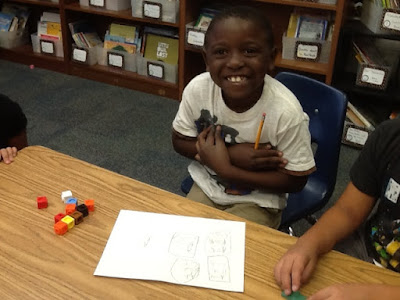We are currently hard at work learning about math problems including "story problems". We began this unit with a challenging problem that said, "There are 10 toy cars in all. Adrian, Bob, and Carla each have a different number of cars." Then I asked the class to find all the different ways they could make that work. They went busily to work and most found about half of the combinations in one class period. (There are over 20 in all.) Here are some happy math explorers:
Another thing we are working on in this unit is modeling math equations. We played "Bears in a Cave" one day. Students took turns hiding some of their 10 bears in the "cave" and their partners had to figure out how many bears were under the cup and write the number sentence (as an addition problem).
Another thing we have been working on in math is what the equals sign means. We have talked about different problems we can write such as 4 = 4 or 6 = 2 + 4 or 3 + 5 = 6 + 2. In all these examples the equals sign shows us that both sides of the equation balance and are equal to the same amount. We actually used blocks and the balance scales from the science lab to act out these equations!
We are still working on modeling some subtraction problems and some problems where we compare two amounts. (Example: There are 4 ducks at the pond and 7 geese. How many more geese are there than ducks?) Students often model these problems by matching up both sides until they run out of something. In this case, you can match 4 ducks with 4 of the geese, but then you have 3 extra geese without partners. Those are the 3 more that answer the math question. We also start to look at problems like that as either a missing addend problem (4 + ___ = 7) or a subtraction problem (7 - 4 = __).
Students need to see how math like this is all around us in our everyday life. One way to help kids with this at home is just to make up problems about whatever you are doing:
We have 4 forks and 4 spoons on the table. How much silverware in all?
There are some carrots in a bowl. Mom eats 2 and then there are 5 carrots left. How many carrots were there to start with?
Dad ate 4 pieces of pizza and I ate 2 pieces. How many more pieces did Dad eat? How many pieces did we eat in all? If the pizza had 8 slices to start with, how many are left for Mom?
There were 9 toy cars in my set, but now I only find 5. How many cars are lost?
When doing problems like this, don't just figure out the answer! Also talk about what the number sentence would be for that problem. And then turn it around and give the child a number sentence like 6 - 2 = ___ and have them make up a story problem for that equation!
We are also working on learning the math combinations that add up to 10 (1 + 9, 2 + 8, 3 + 7, etc.) so we know them "in a snap". Students have an app called "Make 10+" that they can use to practice these combinations.
This unit includes math problems up to 10 and will end next week, but we will come back to this kind of problems solving later in the year with a unit going up to 20.












No comments:
Post a Comment